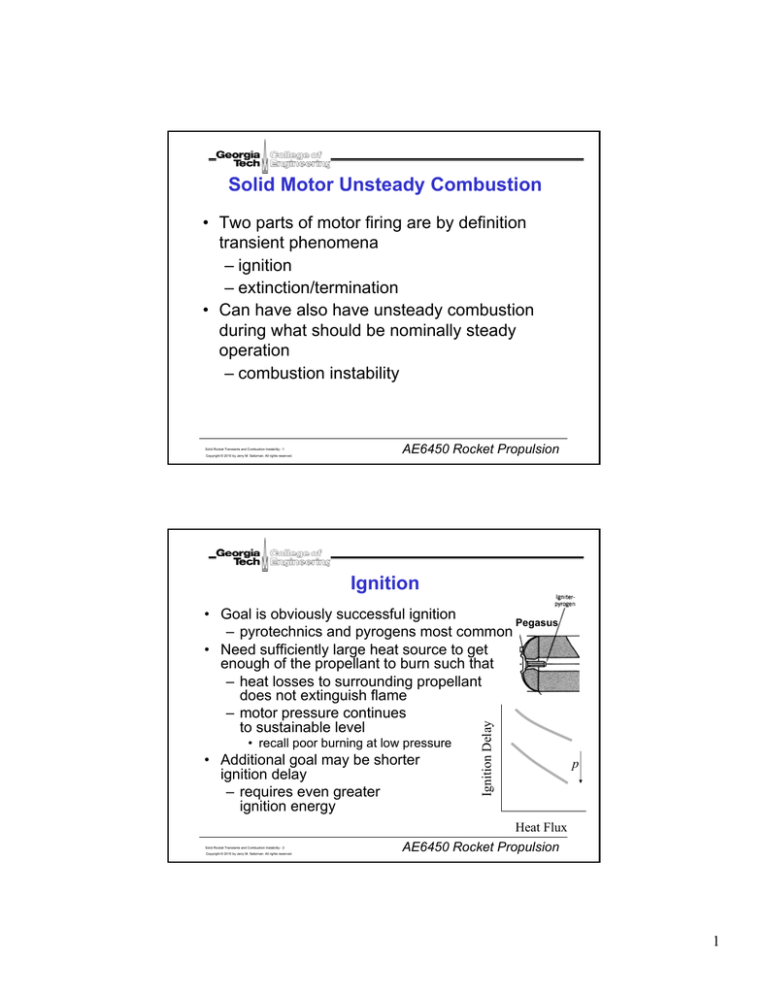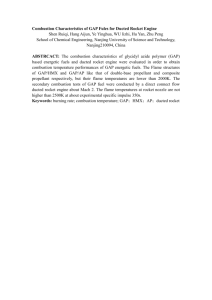
Solid Motor Unsteady Combustion
• Two parts of motor firing are by definition
transient phenomena
– ignition
– extinction/termination
• Can have also have unsteady combustion
during what should be nominally steady
operation
– combustion instability
Solid Rocket Transients and Combustion Instability - 1
Copyright © 2010 by Jerry M. Seitzman. All rights reserved.
AE6450 Rocket Propulsion
Ignition
• recall poor burning at low pressure
• Additional goal may be shorter
ignition delay
– requires even greater
ignition energy
Ignition Delay
• Goal is obviously successful ignition
Pegasus
– pyrotechnics and pyrogens most common
• Need sufficiently large heat source to get
enough of the propellant to burn such that
– heat losses to surrounding propellant
does not extinguish flame
– motor pressure continues
to sustainable level
p
Heat Flux
Solid Rocket Transients and Combustion Instability - 2
Copyright © 2010 by Jerry M. Seitzman. All rights reserved.
AE6450 Rocket Propulsion
1
Extinction/Termination
• Motor will burn itself out when
– no propellant left
– amount of propellant (surface area) remaining is
insufficient to keep pressure at sustainable level
• Motor can extinguish if sudden depressurization (dp/dt)
– flame suddenly lifts farther from
surface; remaining thermal
Pegasus
energy in surface produces too much
for flame to consume nearby and
heat feedback too low
• Depressurization can be caused by
– sudden increase in nozzle throat size
– sudden “opening” of new exhaust path
Solid Rocket Transients and Combustion Instability - 3
Copyright © 2010 by Jerry M. Seitzman. All rights reserved.
AE6450 Rocket Propulsion
Combustion Instability
•
•
Like liquid rockets
– solid motors can experience unsteady operation due to
feedback between motor conditions and propellant burning
(dq/dt and dp/dt)
Unlike liquid rockets
– no separate propellant feed system
– no spray/atomization
– combustion feedback not localized to head end
• combustion occurs along full length for port burning
– chamber volume (and cross-section) not constant
– chamber lined by acoustically dissipative, compressible
material
•
Excellent reference: Nonsteady Burning and Combustion Instability of
Solid Propellants, Vol. 143, Progress in Astro. and Aero., ed., De Luca,
Price and Summerfield
Solid Rocket Transients and Combustion Instability - 4
Copyright © 2010 by Jerry M. Seitzman. All rights reserved.
AE6450 Rocket Propulsion
2
Types of Combustion Instability
• Low frequency
– “non-acoustic”
– spatially uniform pressure oscillations
– ~5-300 Hz
• Intermediate frequency
– longitudinal acoustic modes of motor
– ~15-1500 Hz
• High frequency
– transverse acoustic modes of motor
– ~1000-15,000 Hz
Solid Rocket Transients and Combustion Instability - 5
Copyright © 2010 by Jerry M. Seitzman. All rights reserved.
AE6450 Rocket Propulsion
Characteristic Times
• Instability period
– T = 1/f
• Residence (flushing) time of motor chamber
&
– t res = m m
• Relaxation time of propellant combustion wave
– can be due to thermal wave in condensed phase
of propellant (tth)
– gas flame response (tfl)
Solid Rocket Transients and Combustion Instability - 6
Copyright © 2010 by Jerry M. Seitzman. All rights reserved.
AE6450 Rocket Propulsion
3
Low-Frequency Instability
• Spatially uniform pressure oscillations
– essentially Helmoholtz resonator
• Attributable when T/tres > 1
• Also called
– chuffing/chugging
– bulk mode
– L* (sometimes occurs when L*=V/At too low)
• lowest L* during initial portion of burn
• Primarily driven by response of propellant
combustion to pressure oscillation
• Can be addressed analytically to reasonable degree
– occurs for tres/tth (≡Da) ~ 0.2
Solid Rocket Transients and Combustion Instability - 7
Copyright © 2010 by Jerry M. Seitzman. All rights reserved.
AE6450 Rocket Propulsion
High Frequency Instability
•
p
•
Transverse modes
– λ~2D (“characteristic” lateral dimension of internal volume)
and harmonics
– f ~ a/2D
– D not constant, resonant frequency(s) evolve
If oscillations grow, mean burning rate
also increases
– rapid rise in transient AND mean pressure
(and thus thrust)
– led to catastrophic failures
in early motors
time
Thought to be driven primarily by response of
propellant combustion to pressure oscillations
(as opposed to “velocity-coupling”)
•
Solid Rocket Transients and Combustion Instability - 8
Copyright © 2010 by Jerry M. Seitzman. All rights reserved.
AE6450 Rocket Propulsion
4
High Frequency - Damping
• Growth and maximum amplitude of oscillations
controlled by feedback vs. damping
• Various damping sources
– radiation out of nozzle (typically low level
damping)
– drag of condensed phase material in flow
vel.
• e.g., Al2O3
• depends on particle loading and size distribution
(frequency dependence)
– viscous/turbulent/vortical dissipation of acoustic
energy
• Control approaches: particle size/loading (Al or
inerts); port cross-section; rods and baffles
Solid Rocket Transients and Combustion Instability - 9
Copyright © 2010 by Jerry M. Seitzman. All rights reserved.
AE6450 Rocket Propulsion
Intermediate Frequency Instability
•
•
•
•
•
Longitudinal modes
– λ~L
– modes do not change much with time (but which
modes have energy can)
Can produce large increase in mean burning rate when
oscillation is large
Can be triggered by flow disturbances
– slivers, vortex shedding, …
Damping
– low enough that particle damping small
– nozzle damping higher
Main flow and acoustic wave co-linear
– “velocity-coupling” more important than with
transverse modes
Solid Rocket Transients and Combustion Instability - 10
Copyright © 2010 by Jerry M. Seitzman. All rights reserved.
AE6450 Rocket Propulsion
5
Instability Modeling
• Analysis and characterization of instabilities for
design purposes often broken into
– (non-reacting) acoustic problem
– combustion response function (assumes
feedback based on near surface processes)
– coupled by interface condition (acoustic
admittance)
• Velocity coupling requires more sophisticated
approaches
– one example is jet/vortex shedding from slots
between segments in large segmented motors
Solid Rocket Transients and Combustion Instability - 11
Copyright © 2010 by Jerry M. Seitzman. All rights reserved.
AE6450 Rocket Propulsion
Combustion Response Function
• Measured for propellants in simplified burner
• One standard approach is the “T-burner”
– center vented, symmetric
– frequencies determined by
(changing) length
– low M to minimize mean flow
velocity effects
– analytic model of T-burner used to determine
combustion response function
( f, T, p, …)
Solid Rocket Transients and Combustion Instability - 12
Copyright © 2010 by Jerry M. Seitzman. All rights reserved.
AE6450 Rocket Propulsion
6








